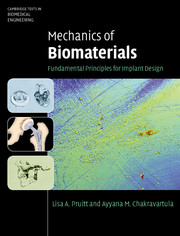Book contents
- Frontmatter
- Contents
- Symbols
- Prologue
- Part I Materials
- Part II Mechanics
- Part III Case studies
- 12 Regulatory affairs and testing
- 13 Orthopedics
- 14 Cardiovascular devices
- 15 Oral and maxillofacial devices
- 16 Soft tissue replacements
- Epilogue
- Appendix A Selected topics from mechanics of materials
- Appendix B Table of material properties of engineering biomaterials and tissues
- Appendix C Teaching methodologies in biomaterials
- Glossary
- Index
- References
14 - Cardiovascular devices
from Part III - Case studies
Published online by Cambridge University Press: 05 June 2012
- Frontmatter
- Contents
- Symbols
- Prologue
- Part I Materials
- Part II Mechanics
- Part III Case studies
- 12 Regulatory affairs and testing
- 13 Orthopedics
- 14 Cardiovascular devices
- 15 Oral and maxillofacial devices
- 16 Soft tissue replacements
- Epilogue
- Appendix A Selected topics from mechanics of materials
- Appendix B Table of material properties of engineering biomaterials and tissues
- Appendix C Teaching methodologies in biomaterials
- Glossary
- Index
- References
Summary
Inquiry
How would you design a novel mechanical heart valve using only synthetic materials?
In the development of medical implants, designers and engineers frequently attempt to replicate both the geometry and function of the natural tissue requiring replacement. This is not true in the case of mechanical heart valves, which utilize designs that mimic the function of natural heart valves but not necessarily the geometry. Perhaps this is because the most important aspect of heart valve design – that is, to provide a long-term method for regulating fluid flow without damaging red blood cells – can be achieved in a number of ways. When considering the lifetime of the device, another challenge presents itself: the average adult heart rate is approximately 72 beats per minute and this translates to nearly 38 million fatigue cycles per year. What are other methods, beyond what is already on the market, to creatively design an implant that can withstand high-cycle fatigue while regulating blood flow without damaging red blood cells?
Historical perspective and overview
Cardiovascular disease can refer to any set of symptoms that affects the cardiovascular system (namely, the heart and blood vessels). Some people are born with cardiovascular disease and others develop it over a lifetime. In this textbook, the focus is on aspects of cardiovascular disease that can be handled through the use of a structural or load-bearing implant. This includes coronary heart disease (a lack of circulation to the heart and surrounding tissue), congestive heart failure (the inability of the heart to pump sufficient blood through the body), and valvular disease (heart valves experiencing regurgitation or incompetency). The electrical stimulation of the heart muscle through the use of a pacemaker will not be discussed, but the reader is encouraged to read the text by Al-ahmed and co-workers (2010) for more information on that topic. The most common type of cardiovascular disease is coronary artery disease, in which the arteries that supply oxygenated blood to the heart become partially blocked by the formation of plaque (the build-up of fibrous tissue, fatty lipids, and calcifications that occurs on the intimal side of vascular wall). This reduction of the arterial lumen, or opening, due to plaque accumulation is one of the characteristics of atherosclerosis (Ross, 1999).
- Type
- Chapter
- Information
- Mechanics of BiomaterialsFundamental Principles for Implant Design, pp. 477 - 504Publisher: Cambridge University PressPrint publication year: 2011



